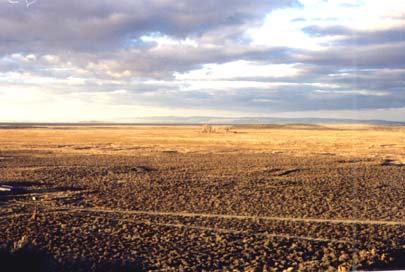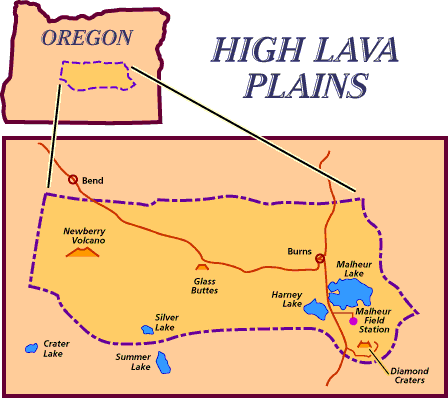


The High Lava Plains physiographic province covers an area of approximately 7500 square miles and is located roughly in the center of Oregon. The region is a relatively even plateau which has been uplifted to an average altitude of a mile above sea level. Minimal weathering of the geological features makes this fascinating region ideal for study. It is located in the rain shadow of the Cascade Range and receives less than 50 cm of precipitation annually. Both tectonic and volcanic forces are strikingly recorded here. Many kinds of volcanic activities and materials can be found. And the region has been heavily faulted by shearing forces of underlying plates.

About half way between Bend and Burns we stopped at Glass Buttes. Mineral hunters have picked over this complex of shield volcanoes for the outstanding varieties of obsidian found here. Very few pieces larger than fist size now remain on the surface. On the western edge of this province the very large complex of Newberry Volcano also has large obsidian flows. These exampes of volcanic glass form from extremely viscous lavas of high silica content which have cooled and hardened very rapidly. An excellent Internet resource for obsidian is the Obsidian Lab. These same geologists have a page on the Glass Buttes with a map and other details. These fine websites have no doubt contributed to the over harvesting of mineral specimens... The rocks exposed along the highway between Bend and Burns are predominantly basalt lava flows. The terraine is nearly treeless. North of Brothers are exposures of Clarno andesite. Many rhyolitic lavas and ash are also found in this province. These strikingly different lava compositions are attributed to the chronology of the rising plume of magma. Early in a flow, the lavas tend to be molten compositions of deep mantle chemistry, highly mafic, hotter and more fluid in nature. Later, as the plume melts and mixes in country rock of the upper crust, the composition increases in silica content and the physical properties change, become more viscous, and cooler by several hundred degrees. Highway 20 nearly parallels the vast array of the Brothers Faults. These faults and this fault zone are thought to be the result of dynamic shearing forces which have wrenched the region between opposing movements of two crustal blocks. Some of these faults opened to rising magma and produced many volcanic events right up to nearly present time.

|
|